Top 10 Fuel Economy Lists
 |
But First Snide's Remarks: I believe that our country, our economy and our ecology will be better when MPG becomes just another personal economic or performance choice, not a national security issue. What is really important to our future is not a vehicle's MPG, but what fuel the car or truck uses...25 MPG on Flex-Fuel is much better all around than 100 MPG on gasoline.
As you will see below the top ten higher mileage cars are all small, impractical for families and for many American roads and highways. Higher gasoline MPG may sound good, but I believe is a metaphor for “isn’t gasoline great” a sad mindset (enabled by our oil company loving (partners?) politicians who seemingly avoid legislation that could eliminate big oil's ability to control our freedom to be mobile virtually immediately), no matter what the "improvement" we believe MPG is actually is an abbreviation for "More Profit(from)Gasoline"...and by the way it is also bad for our children's health and future economic well being. MPG and oil both three letters that go together like trans-fats and heart attacks; cancer and toxic wastes; fast foods and obesity; DDT and species elimination, and OPEC and Anti-Democracy.
I believe that any MPG improvement pronouncement should be understood as “how much less are you beating your children now”.
We The People need to change the MPG mindset into CPM (Cost Per Mile), which we believe better reflects a future motoring reality... we should eliminate references and deification of MPG, just as we must eliminate imported oil based fuels as our primary mobility energy source.
We believe that in the oil free future every driver’s refueling events will be made with conscious personal choices…each weekly(monthly) fill-up should be decided by each driver determining their vehicle’s calculated CPM rating using each available fuel’s cost at that exact moment, along with considering the type of driving they will be doing that week and which fuel makes their vehicle “drive better”…it will be their choice.
And using Internet technology, fuel companies can establish and maintain their customer's Personal Carbon Usage Accounts, which will allow motorists who choose to reduce their carbon footprint to instantly benefit monetarily by trading or selling their unused carbon allotment in real time…it will be their choice.
At some point in the future all approved mobility fuels will be ubiquitous...Gas Stations will become CPM Refueling and Recharging Stations, required by law to provide customers with access to all approved and taxed Fuels (how else can get the money to fix our roads, highways and bridges?).
Liquid fuel pumps must change from just vending 3 octane levels of gasoline plus diesel, to offering an infinite blend of Gasoline, Ethanol, Propane, LNG, and liquid Hydrogen and everything else our smart engineers can come up with.
Gaseous fuel pumps must vend CNG, Hydrogen, Methane and other formerly exotic concoctions that will power tomorrow’s vehicles.
Every Refueling Island must offer Recharge connections for every Electric Vehicle technology, and compressors for Air Powered vehicles.
And each station must offer battery change out for customers of Project Better Place and its competitors.
In a new sensible world, alternative fuel choices will include ALL of them…in the future cars and truck will be built with its buyer’s choice of power plant(s)…some vehicle buyers will want their vehicles to run on every approved and supported fuel available…then and only then can the marketplace choose a winner.
In this future, vehicle buyers will have the choice and will be in control...their budget and their practical and emotional needs will determine which vehicle and which fuel they will favor...flex fuel combination's will be offered that reduce CPM, while maximizing performance...what an idea...and a non MPG world is the place to start...
Big Cars with Choice, Not Small Cars With No Choice, Is What's Good for America. What do you think? msnide@theautochannel.com
Top Ten Fuel Economy Lists
Fueleconomy.gov's Top Ten EPA-Rated Fuel Sippers (2011)
2011 vehicles are ranked by city, then highway MPG. In the event of a tie, multiple vehicles may share the same ranking. Electric vehicles are not considered for this list.
| 1. |
|
2011 Toyota Prius | City 51 | Highway 48 |
| 4 cyl, 1.8 L, Automatic (variable gear ratios), Regular | ||||
| 2. |
|
2011 Ford Fusion Hybrid FWD | City 41 | Highway 36 |
| 4 cyl, 2.5 L, Automatic (variable gear ratios), Regular | ||||
|
|
2011 Mercury Milan Hybrid FWD | City 41 | Highway 36 | |
| 4 cyl, 2.5 L, Automatic (variable gear ratios), Regular | ||||
|
|
2011 Lincoln MKZ Hybrid FWD | City 41 | Highway 36 | |
| 4 cyl, 2.5 L, Automatic (variable gear ratios), Regular | ||||
| 3. |
|
2011 Honda Civic Hybrid | City 40 | Highway 43 |
| 4 cyl, 1.3 L, Automatic (variable gear ratios), Regular | ||||
| 2011 Honda Insight Hybrid | City 40 | Highway 43 | ||
| 4 cyl, 1.3 L, Auto (variable gear ratios and AV-S7), Regular | ||||
| 4 |
|
2011 Honda CR-Z | City 35 | Highway 39 |
| 4 cyl, 1.5 L, Auto(AV-S7), Regular | ||||
| 5. |
|
2011 Lexus HS 250h | City 35 | Highway 34 |
| 4 cyl, 2.4 L, Automatic (variable gear ratios), Regular | ||||
| 6. |
|
2011 Ford Escape Hybrid FWD | City 34 | Highway 31 |
| 4 cyl, 2.5 L, Automatic (variable gear ratios) | ||||
|
|
2011 Mazda Tribute Hybrid 2WD | City 34 | Highway 31 | |
| 4 cyl, 2.5 L, Automatic (variable gear ratios) | ||||
|
|
2011 Mercury Mariner Hybrid FWD | City 34 | Highway 31 | |
| 4 cyl, 2.5 L, Automatic (variable gear ratios) | ||||
| 7. |
|
2011 smart fortwo cabriolet | City 33 | Highway 41 |
| 3 cyl, 1.0 L, Auto(AM5) | ||||
|
|
2011 smart fortwo coupe | City 33 | Highway 41 | |
| 3 cyl, 1.0 L, Auto(AM5) | ||||
| 8 |
|
Nissan Altima Hybrid | City 33 | Highway 33 |
| 4 cyl, 2.5 L, Automatic (variable gear ratios) | ||||
| 9. |
|
2011 Lexus RX 450h | City 32 | Highway 28 |
| 6 cyl, 3.5 L, Auto(AV-S6) | ||||
| 10. |
|
2011 Honda CR-Z | City 31 | Highway 37 |
| 4 cyl, 1.5 L, Manual 6-spd, Regular |
Fueleconomy.gov's Top Ten EPA-Rated Fuel Sippers (1984 to present)
Vehicles are ranked based on EPA's unrounded combined rating. In the event of a tie, multiple vehicles may share the same ranking. Electric vehicles are not considered for this list.
| 1. |
|
Honda Insight Model Year 2000 | Combined 53 | |
|
3 cyl, 1.0L, Manual 5-spd, Regular
• Similar models that qualify... |
City 49 | Highway 61 | ||
| 2. |
|
Toyota Prius Model Years 2010-2011 | Combined 50 | |
|
4 cyl, 1.8L, Automatic (variable gear
ratios), Regular
• Similar models that qualify... |
City 51 | Highway 48 | ||
| 3. |
|
Chevrolet Sprint ER Model Year 1986 | Combined 48 | |
|
3 cyl, 1.0L, Manual 5-spd, Regular
• Similar models that qualify... |
City 44 | Highway 53 | ||
| 4. |
|
Geo Metro XFI Model Years 1990-1994 | Combined 47 | |
|
3 cyl, 1.0L, Manual 5-spd, Regular
• Similar models that qualify... |
City 43 | Highway 52 | ||
| 5. |
|
Honda Civic CRX HF Model Years 1986-1987 | Combined 46 | |
|
4 cyl, 1.5L, Manual 5-spd, Regular
• Similar models that qualify... |
City 42 | Highway 51 | ||
| 6. |
|
Honda Civic HB VX Model Years 1994-1995 | Combined 43 | |
|
4 cyl, 1.5L, Manual 5-spd, Regular
• Similar models that qualify... |
City 39 | Highway 50 | ||
| 7. |
|
Honda Civic Hybrid Model Years 2006-2010 | Combined 42 | |
|
4 cyl, 1.3L, Automatic (variable gear
ratios), Regular
• Similar models that qualify... |
City 40 | Highway 45 | ||
| 8. |
|
Honda Insight Model Years 2010-2011 | Combined 41 | |
|
4 cyl, 1.3L, Auto(AV-S7), Regular
• Similar models that qualify... |
City 40 | Highway 43 | ||
| 9. |
|
Toyota Prius Model Years 2001-2003 | Combined 41 | |
| 4 cyl, 1.5L, Automatic (variable gear ratios), Regular | City 42 | Highway 41 | ||
| 10. |
|
Chevrolet Sprint Model Year 1989 | Combined 41 | |
| 3 cyl, 1.0L, Manual 5-spd, Regular | City 38 | Highway 45 | ||
|
|
Suzuki Swift Model Year 1989 | Combined 41 | ||
| 3 cyl, 1.0L, Manual 5-spd, Regular | City 38 | Highway 45 | ||
Vehicles are ranked based on EPA's unrounded combined rating. In the event of a tie, multiple vehicles may share the same ranking. Only the most efficient configuration of a particular model is presented for a given rank — variants of a ranked model are listed as "similar models" if they would have otherwise made the list. Models classified under different EPA size classes, however, are ranked separately.
Fueleconomy.gov's Top Ten Real-World Fuel Sippers (1984 to present)
| 1. |
|
Honda Insight Model Years 2004-2006 |
User Average 71.4
(based on 12 Your MPG
users)
|
|
3 cyl, 1.0L, Manual 5-spd, Regular
• Similar models that qualify... |
EPA Combined 52 | ||
| 2. |
|
Geo Metro XFI Model Years 1990-1994 |
User Average 49.9
(based on 13 Your MPG
users)
|
| 3 cyl, 1.0L, Manual 5-spd, Regular | EPA Combined 47 | ||
| 3. |
|
Honda Insight Model Year 2010 |
User Average 49.7
(based on 15 Your MPG
users)
|
|
4 cyl, 1.3L, Auto(AV-S7), Regular
• Similar models that qualify... |
EPA Combined 41 | ||
| 4. |
|
Toyota Prius Model Year 2010 |
User Average 49.5
(based on 112 Your MPG
users)
|
|
4 cyl, 1.8L, Automatic (variable gear
ratios), Regular
• Similar models that qualify... |
EPA Combined 50 | ||
| 5. |
|
Chevrolet Metro Model Year 1999 |
User Average 48.4
(based on 10 Your MPG
users)
|
| 3 cyl, 1.0L, Manual 5-spd, Regular | EPA Combined 37 | ||
| 6. |
|
Volkswagen Jetta Wagon Model Years 2002-2003 |
User Average 48.2
(based on 22 Your MPG
users)
|
| 4 cyl, 1.9L, Manual 5-spd, Diesel | EPA Combined 39 | ||
| 7. |
|
Honda Civic Hybrid Model Years 2003-2005 |
User Average 47.9
(based on 20 Your MPG
users)
|
|
4 cyl, 1.3L, Manual 5-spd, Regular
• Similar models that qualify... |
EPA Combined 41 | ||
| 8. |
|
Volkswagen Golf Model Years 2000-2003 |
User Average 47.2
(based on 52 Your MPG
users)
|
| 4 cyl, 1.9L, Manual 5-spd, Diesel | EPA Combined 38 | ||
| 9. |
|
Honda Civic HB VX Model Years 1992-1995 |
User Average 46.6
(based on 13 Your MPG
users)
|
| 4 cyl, 1.5L, Manual 5-spd, Regular | EPA Combined 43 | ||
| 10. |
|
Volkswagen Jetta Model Years 1985-1991 |
User Average 46.4
(based on 13 Your MPG
users)
|
| 4 cyl, 1.6L, Manual 5-spd, Diesel | EPA Combined 34 |
Vehicles are ranked based on fuel economy records provided by our users through Your MPG. Vehicles are only ranked if ten or more drivers submitted fuel economy estimates. If a model has variants that are nearly identical (e.g., same number of cylinders, engine displacement, transmission, fuel type, and EPA combined fuel economy rating), those records are combined and averaged. Variants that are not similar enough to be combined are included under "similar models" if they would have otherwise made the list. Only the most efficient configuration of a particular model is presented for a given rank. This list is updated weekly as new data are submitted by Your MPG members. Electric vehicles are not considered for this list.
Top Ten Misconceptions About Fuel Economy
| 1. |
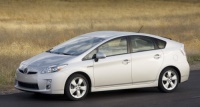 You have to drive a small car to get good fuel economy.
You have to drive a small car to get good fuel economy.
Advanced technologies like hybrid drivetrains, diesel engines, direct fuel injection, turbocharging, advanced transmissions, low rolling resistance tires and aerodynamic designs are allowing standard-sized vehicles to be very fuel efficient. For the 2010 model year, five of the top ten most efficient vehicles are midsized cars, with a midsized car taking the top spot. |
2. |
 Manual transmissions always get better fuel economy than
automatics.
Manual transmissions always get better fuel economy than
automatics. Advances in automatic transmissions have improved their efficiency to the point that the automatic version of a vehicle often gets the same or better fuel economy than the version with a manual transmission. For vehicles offered in both automatic and manual transmissions, consumers can easily compare fuel economy at http://www.fueleconomy.gov/feg/findacar.htm. |
| 3. |
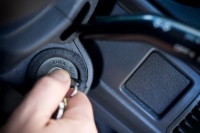 It takes more fuel to start a vehicle than it does to let
it idle.
It takes more fuel to start a vehicle than it does to let
it idle. Modern fuel injected engines start very efficiently, especially when warmed up. Idling can use a quarter to a half gallon of fuel per hour — depending on your vehicle's engine size — costing you about 1 to 2 cents per minute. Turn off your engine when your vehicle is sitting still, except when you are waiting in traffic or waiting in a line where you would need to turn it on and off frequently. Restarting your engine too frequently can wear out your starter. |
| 4. |
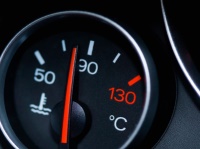 Vehicles need to warm up before they can be driven.
Vehicles need to warm up before they can be driven.
Modern vehicles can be driven within seconds of being started, though the engine should not be subjected to extreme loads until it has reached its normal operating temperature. Plus, the quickest way to warm up a vehicle's engine is to drive it. |
| 5. |
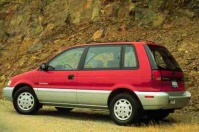 As a vehicle ages, its fuel economy decreases
significantly.
As a vehicle ages, its fuel economy decreases
significantly. A vehicle that is properly maintained will retain its efficiency for many years. The EPA tests vehicles with about 5,000 miles on the odometer to account for the break-in period since a vehicle's fuel economy will typically continue to improve over the first several years of ownership. Vehicles that are 10 or even 15 years old will experience little decrease in fuel economy if properly maintained. |
| 6. |
 Replacing your air filter will help your car run more
efficiently.
Replacing your air filter will help your car run more
efficiently. This is true for older vehicles with carbureted engines, but modern fuel-injected engines have onboard computers that automatically adjust the fuel-air ratio to the proper level. Changing a dirty air filter won't increase your fuel economy, but it might improve your engine's performance. |
| 7. |
 Aftermarket additives and devices can dramatically improve
your fuel economy.
Aftermarket additives and devices can dramatically improve
your fuel economy. Excluding full conversions that meet all EPA certification standards, tests have shown that such devices and additives do not improve fuel economy and may damage your engine and/or increase your tailpipe emissions. For further information, see "Gas-Saving Products: Fact or Fuelishness?" by the Federal Trade Commission. |
| 8. |
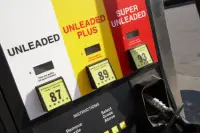 Using premium fuel improves fuel economy.
Using premium fuel improves fuel economy.
Unless your vehicle was specifically designed for premium fuel or knocks severly with regular fuel, you will probably experience no benefit from using premium fuel over regular. Consult your owner's manual to see whether premium is recommended and under what conditions (e.g., towing). |
| 9. |
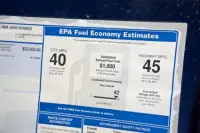 The EPA fuel economy estimates are a government guarantee
on what fuel economy each vehicle will deliver.
The EPA fuel economy estimates are a government guarantee
on what fuel economy each vehicle will deliver. The primary purpose of EPA fuel economy estimates is to provide consumers with a uniform, unbiased way of comparing the relative efficiency of vehicles. Even though the EPA's test procedures are designed to reflect real-world driving conditions, no single test can accurately model all driving styles and environments. Differing fuel blends will also affect fuel economy. The use of gasoline with 10% ethanol can decrease fuel economy by about 3% due to its lower energy density. |
| 10. |
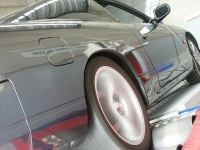 All vehicles are tested for fuel economy.
All vehicles are tested for fuel economy.
Current testing regulations only require light-duty vehicles of 8,500 lbs or less to be tested for fuel economy. Several popular models, such as the Ford F250/350, Chevrolet/GMC 2500/3500, and Dodge 2500/3500 vehicles, exceed this weight limit and are therefore not tested and have no official fuel economy rating. The EPA also does not test motorcycles or four wheel vehicles that are not legal for highway driving like neighborhood vehicles. Beginning with the 2011 model year, passenger vehicles (vans and SUVs but NOT pickup trucks) up to 10,000 lbs will be required to have fuel economy labels. |
These misconceptions are based on user feedback to www.fueleconomy.gov and are listed in no particular order.


